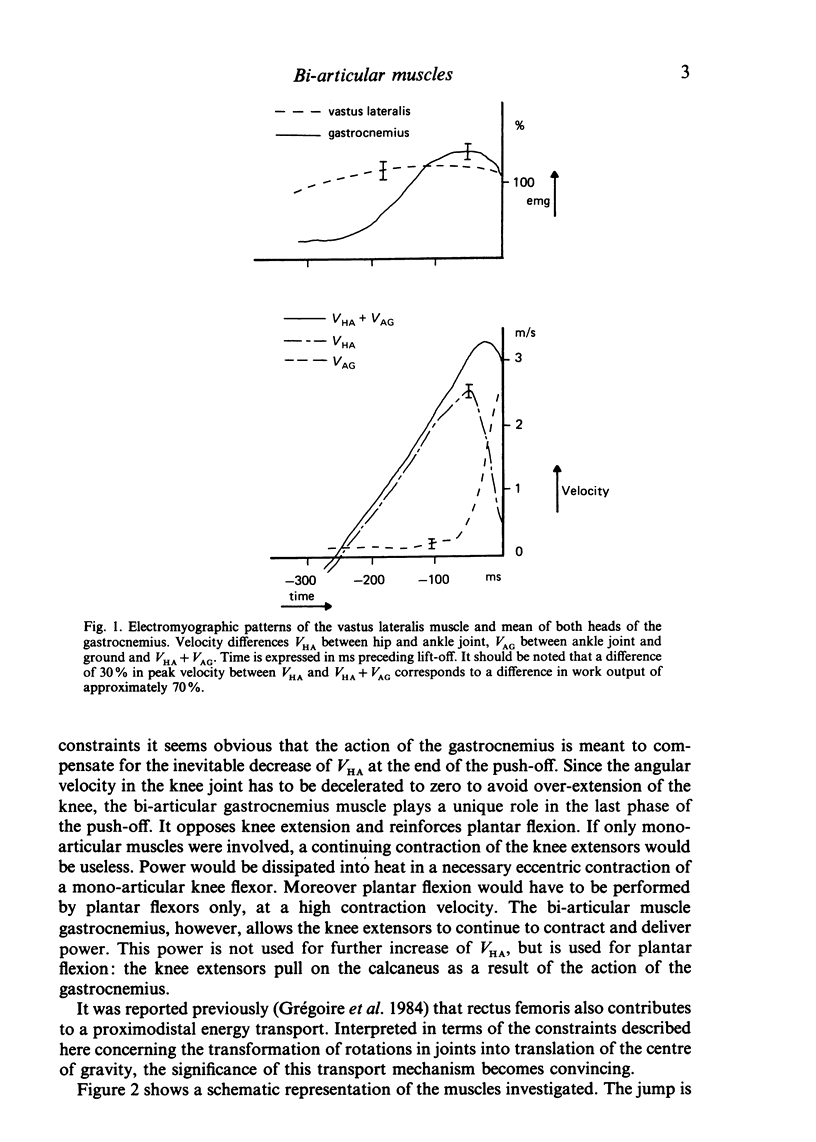Abstract
Actions of muscles that pass over more than one joint are mainly described with respect to movements in the joints that are crossed. In a previous study of push-off without plantar flexion it was shown that the transformation of knee angular velocity into translation of the body is constrained by the fact that velocity difference between hip and ankle has to reach its peak value a long time before the knee is extended. The present study was meant to test the hypothesis that the action of the gastrocnemius can be understood in the light of this constraint. Vertical jumps of ten subjects were analysed cinematographically. Electromyographic signals were derived from knee extensors and plantar flexors simultaneously. The results show that the peak velocity difference between hip and ankle is reached at a mean knee angle of 132 degrees. At that instant a rapid plantar flexion starts, reinforced by a strong increase of activation of gastrocnemius. It is suggested that the bi-articular character of the gastrocnemius muscle enables the knee extensors to continue to deliver work which is transported to the ankle where it is used for plantar flexion. This optimal use of the capabilities of proximally located muscles would not be possible if man had mono-articular muscles only.
Full text
PDF




Selected References
These references are in PubMed. This may not be the complete list of references from this article.
- Alexander R. M., Bennet-Clark H. C. Storage of elastic strain energy in muscle and other tissues. Nature. 1977 Jan 13;265(5590):114–117. doi: 10.1038/265114a0. [DOI] [PubMed] [Google Scholar]
- Bobbert M. F., Huijing P. A., van Ingen Schenau G. J. A model of the human triceps surae muscle-tendon complex applied to jumping. J Biomech. 1986;19(11):887–898. doi: 10.1016/0021-9290(86)90184-3. [DOI] [PubMed] [Google Scholar]
- Bobbert M. F., Huijing P. A., van Ingen Schenau G. J. An estimation of power output and work done by the human triceps surae muscle-tendon complex in jumping. J Biomech. 1986;19(11):899–906. doi: 10.1016/0021-9290(86)90185-5. [DOI] [PubMed] [Google Scholar]
- Engberg I., Lundberg A. An electromyographic analysis of muscular activity in the hindlimb of the cat during unrestrained locomotion. Acta Physiol Scand. 1969 Apr;75(4):614–630. doi: 10.1111/j.1748-1716.1969.tb04415.x. [DOI] [PubMed] [Google Scholar]
- Gregoire L., Veeger H. E., Huijing P. A., van Ingen Schenau G. J. Role of mono- and biarticular muscles in explosive movements. Int J Sports Med. 1984 Dec;5(6):301–305. doi: 10.1055/s-2008-1025921. [DOI] [PubMed] [Google Scholar]
- Hof A. L., Geelen B. A., Van den Berg J. Calf muscle moment, work and efficiency in level walking; role of series elasticity. J Biomech. 1983;16(7):523–537. doi: 10.1016/0021-9290(83)90067-2. [DOI] [PubMed] [Google Scholar]
- Winter D. A. Moments of force and mechanical power in jogging. J Biomech. 1983;16(1):91–97. doi: 10.1016/0021-9290(83)90050-7. [DOI] [PubMed] [Google Scholar]
- van Ingen Schenau G. J., de Groot G., de Boer R. W. The control of speed in elite female speed skaters. J Biomech. 1985;18(2):91–96. doi: 10.1016/0021-9290(85)90002-8. [DOI] [PubMed] [Google Scholar]


